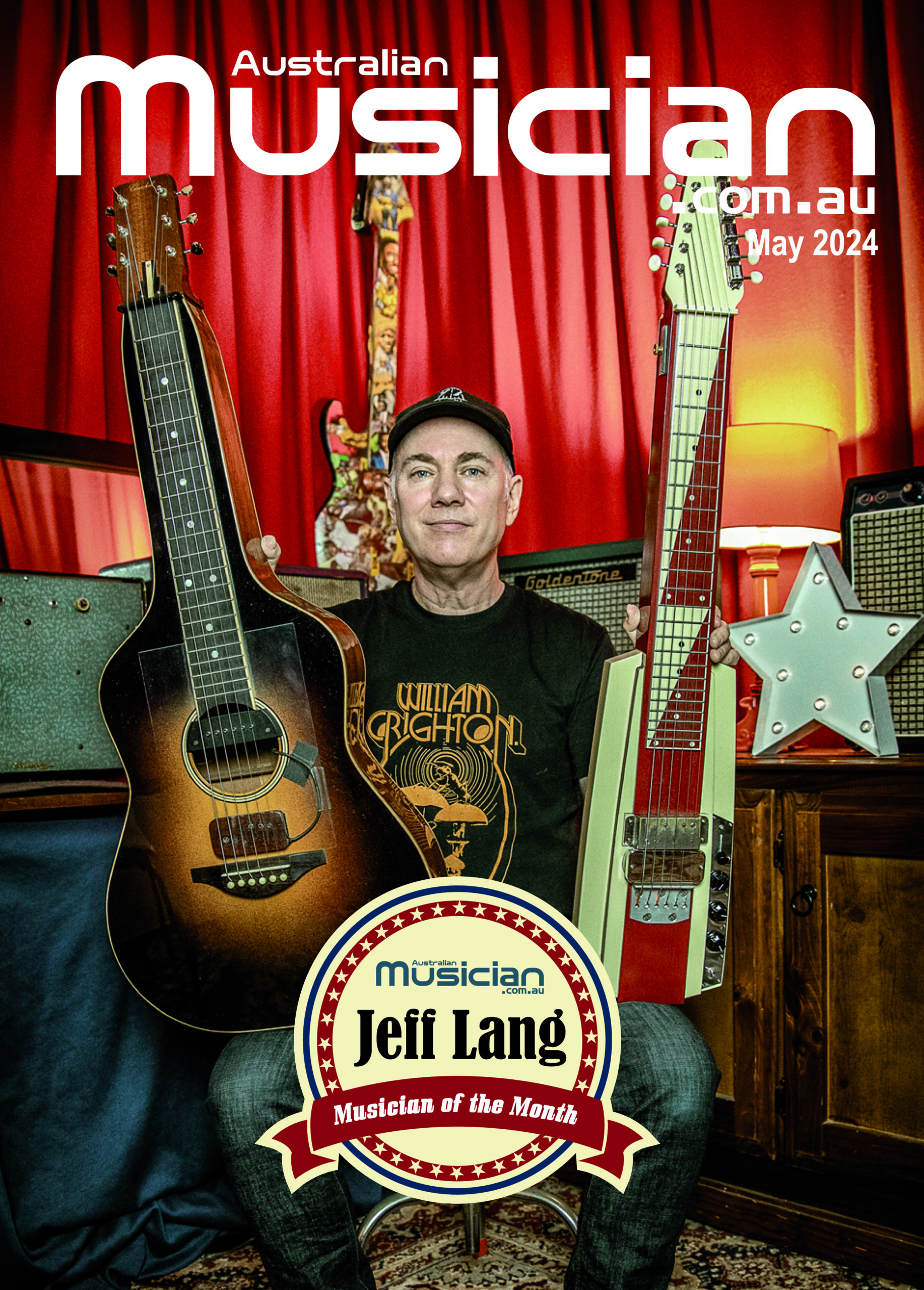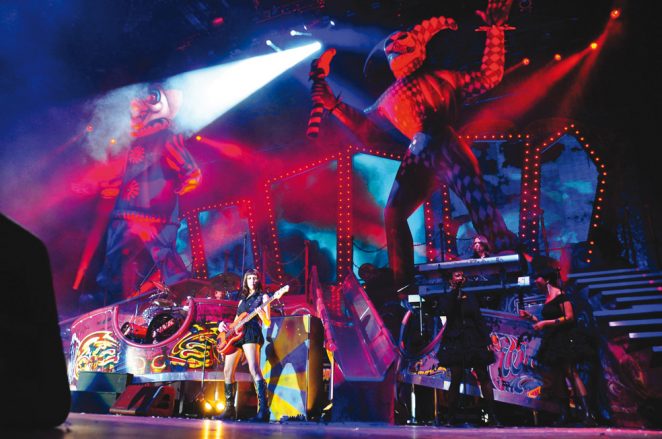
PINK BAND AT SOUNDCHECK EXCLUSIVE!
by Greg Phillips. Photos by Marty Williams. 2009
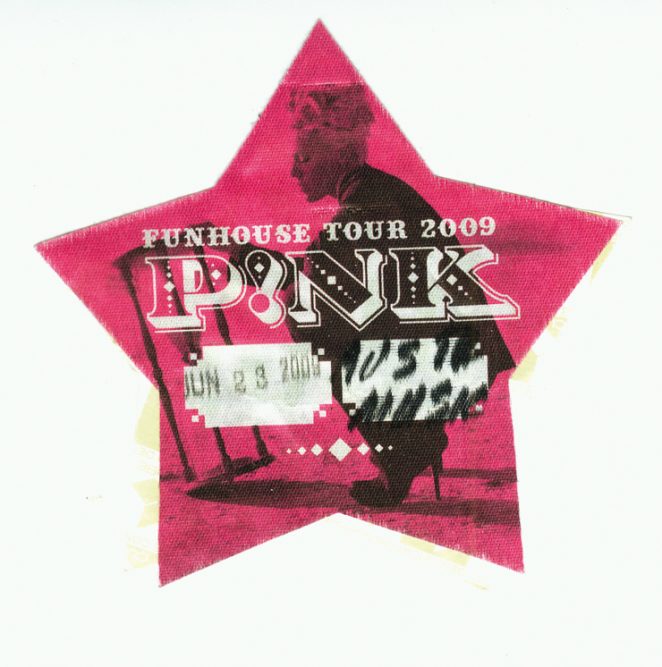 It’s no surprise that many Australians fell instantly in love with Pink’s sense of fun and vibrant brand of pop, snapping up albums such as ‘I’m Not Dead’ and ‘Funhouse’ in huge numbers. However the extent of tickets sales for her recent ‘Funhouse’ tour tallying over 650,000, left everyone dumbfounded. Pink and band were literally in Australia for months, playing 58 gigs to packed houses with her stunning psycho-circus extravaganza. The two hour show was one of the biggest rock productions to hit Australia in a long time and featured giant inflatable clowns, dancers, aerial acrobatics, slippery dips, mirrors, confetti rain, an explosion of colour, and most importantly, a group of seriously talented musicians pumping out an incredibly tight and rockin’ musical soundscape.
It’s no surprise that many Australians fell instantly in love with Pink’s sense of fun and vibrant brand of pop, snapping up albums such as ‘I’m Not Dead’ and ‘Funhouse’ in huge numbers. However the extent of tickets sales for her recent ‘Funhouse’ tour tallying over 650,000, left everyone dumbfounded. Pink and band were literally in Australia for months, playing 58 gigs to packed houses with her stunning psycho-circus extravaganza. The two hour show was one of the biggest rock productions to hit Australia in a long time and featured giant inflatable clowns, dancers, aerial acrobatics, slippery dips, mirrors, confetti rain, an explosion of colour, and most importantly, a group of seriously talented musicians pumping out an incredibly tight and rockin’ musical soundscape.
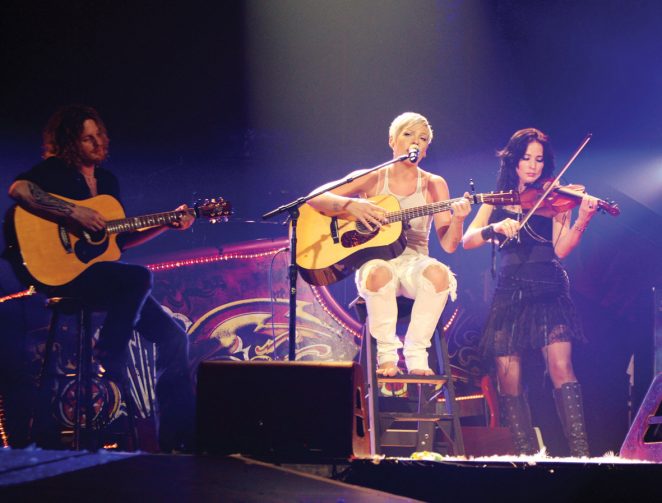
It’s around 5pm on a crisp June afternoon at Melbourne’s Rod Laver Arena and Pink’s Musical Director Paul Mirkovich is on stage running the band through some of the night’s set. Pink is not well and won’t attend today’s soundcheck preferring to rest up for the night (Doctors suggest due to an ear infection, she not swing upside down from her trapeze tonight, so the song ‘Sober’ is cut from the set). Paul is known to many as the MD of successful American reality TV series Rockstar INXS, a show which required his band to learn up to 50 songs a week and sometimes changing keys and tempos on the fly, live on national television. Needless to say, Mirkovich has the goods to deliver a major musical production such as the ‘Funhouse’ show. Australian Musician’s Greg Phillips sat down with Paul and all of Pink’s band members to discuss their musical careers and their roles in this production.
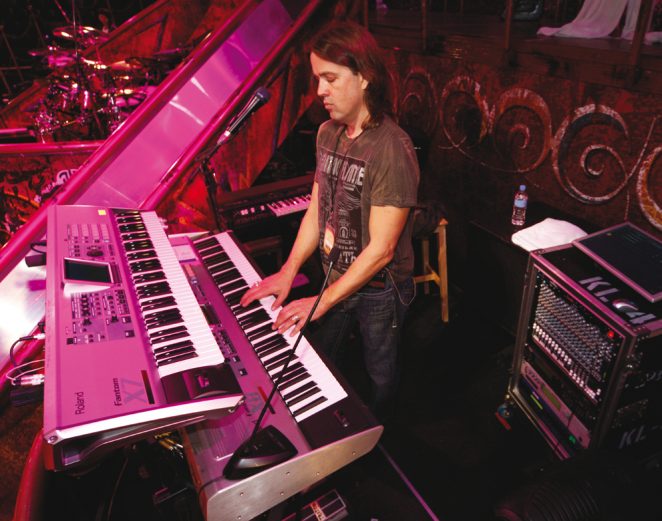
PAUL MIRKOVICH – MUSICAL DIRECTOR & KEYBOARDS
You had some very impressive tutors during your early compositional study. Henry Mancini and Lalo Schifrin were a couple. Those are pretty amazing guys. How important were those years to your career?
Paul: I went to a school called the Dick Grove School of Music in San Fernando Valley. It was a professional school where all the guys doing stuff in the record industry or film business, they would come and teach at the school. So Henry Mancini and Lalo Schifrin and Nelson Riddle, all these great arrangers would come in. They were all guys who did it professionally and had a lot of nuts and bolts knowledge on how to get in there and get a job done. It doesn’t matter if you are orchestrating for drums and horns or guitar and synthesiser, everything still has to have its place. So if it’s Pink or whoever I am working with, the the sound is supposed to sound like the records. You have to know how to recreate those sounds by getting the players to play what they can. Like Justin’s guitar parts … he can’t play three parts at once, even though he’s a badass (looking at Justin Derrico while he speaks). So you’ve got to put all that stuff in the box to play with him. You have to figure out what synthesiser sounds we are going to play live, what stuff is going to run from the box … figure out the loops and weird effects. Sometimes in some of these songs there are 65 or 70 tracks, and with an orchestra there are 65 or 70 instruments so it’s similar. Everything has its place. So that early training in orchestration and knowing instrument families, organisationally helped me a lot.
When I spoke with the INXS guys about the TV show Rockstar they were telling me how impressed they were by the band, which you lead. It must have been a challenging role for you?
Paul: It was tough. There were some times when we’d be playing ‘Bohemian Rhapsody’ or ‘We Are The Champions’ and a guy would say, “we have to take it up a minor third”, which is fine if you are going to play rock ‘n’ roll. It’s easy. But when you are playing something more complicated on the fly, and with cameras rolling, you have to change the key, change the tempo, change the feel, cut and paste different things … that gig was amazing. We did two years of it, like 145 songs live all different keys, different feels and we never knew what was going to walk through the door. The thing about it was … I never thought to myself, or never let the other guys think, we can’t do it. Because the moment you think you can’t do it, you won’t. But if you don’t think about it, you’d be amazed at what you can do under pressure.
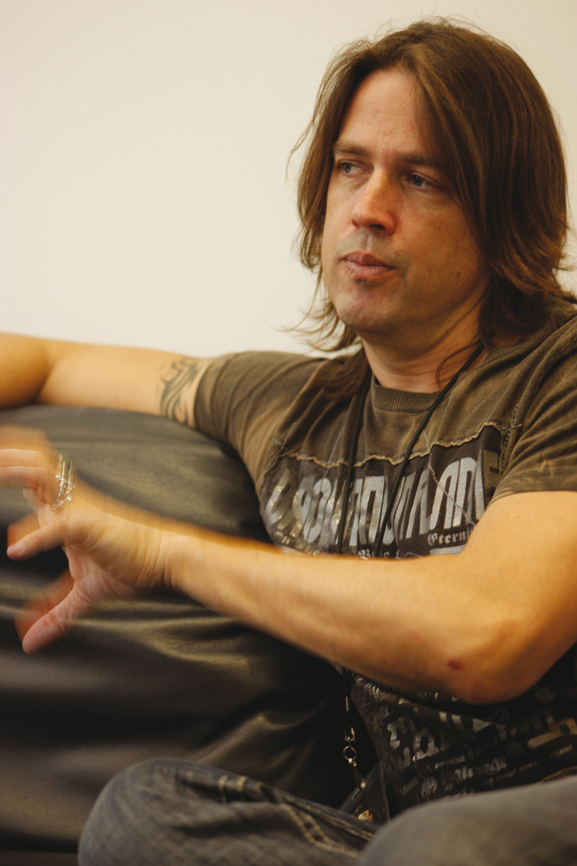 Let’s talk about preparing Pink’s show. You had around six weeks rehearsal prior to the tour I believe?
Let’s talk about preparing Pink’s show. You had around six weeks rehearsal prior to the tour I believe?
Paul: In the first few weeks we were learning all the songs, programming sounds. We would rehearse during the day then excuse everyone and I would program synthesiser sounds and digital audio for the digital audio portions. Justin would program his guitar sounds. Mark would program his electronic drums. So the body of the day was usually spent learning how to play the songs. Then everyone goes off into their little corners to create the sounds they need to make that speak like they are supposed to. I had a lot of compositional work I had to do before and or after rehearsals. Some days Jason Chapman, who is the usual musical director on the road would run the band. I would stay home and program sounds and bring it in half way through the day to work on with the band. The next couple of weeks are getting the material together with the other elements the dancers, video etc. Pink comes in during that time and works with us. We think about intros and segues. The second two weeks we start to put a show together that has a flow. Compositionally, I fill the holes. If Pink needs a costume change or there is a big set piece that needs to come in or out, I need to cover that. The last two weeks of rehearsal we were in Nice, France, in the arena where the first gig was to be. We’d practice every day still and beyond what we have to do, the technical people have to practice with us to make sure all the cues are right and every body has time to get to their positions.
So what kind of things can go wrong?
Paul: (Turns to guitarist Justin Derrico) What happened the other night with your guitar, Justin?
Justin: I have this really long-assed guitar solo, probably four minutes long, sometimes six minutes. It’s at the end of ‘Babe I’m Gonna Leave You’, the Led Zeppelin song. My rig is pretty complex. I have a lot of stuff going on. It gets to my guitar solo and my guitar just completely cuts out. So I went up to my other rig and that wasn’t working either. We went straight into ‘Bohemian Rhapsody’ without my guitar. It was an absolute nightmare.
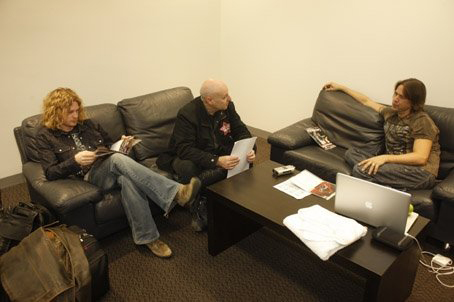
Paul: I mean not that that sort of thing happens often. The stuff that usually goes wrong is the technical stuff. Like when Pink was stuck twenty feet up in the air when the harness would not let her down. It was a safety issue. If the harness gets off the track, everything stops and it wont let it go up or down. She had to unclip herself, climb onto a silk and let herself down. In the meantime we’re playing the outro of ‘Get The Party Started’ about 27 million times because she couldn’t get off.
Is there an element of triggering in this show?
Paul: We have stuff running from the box on a lot of songs. On those songs, we’re locked up to code. Everything is locked up to the video or lighting. The way I like to do it is the band is still playing as much as they can physically play. There is nothing being played back by the box that we couldn’t play live. But if Justin is playing a guitar part and Kat is playing another guitar part, but there’s another part on the record which is important, it has to be heard. It can’t not be heard and we now have the technology where we can create that. It doesn’t lessen the impact of what the guys on stage are dong, it adds to it. One of the major differences in the way we use Pro Tools as opposed to the way other shows are run is that there is never a (pre-recorded) lead vocal. She wont have it. We’ve offered it to her before. Like when she’s hanging upside down 30 feet in the air. We said, you know you could make this a lot easier on yourself if you didn’t have to sing, but she’s like, no that would be cheating. She’s unique like that and one of only two artists in the last 6 or 7 years I have worked with who won’t allow that to happen. There are certain other things too. Most records these days have a live drum kit, then they a have a loop. If you take the loop away you are not hearing the song anymore. What the drummer does is give it the human feel. What the loop does is give it that mechanised pop thing people expect.
Everyone in this band is an amazing musician. You have to be to play at this level, but does Pink give you any direction or ask anything specific of you?
Paul: Oh yeah. If there is something she doesn’t like, she lets you know very strongly. She doesn’t know music in a sense that she can say “play a nine instead of a third”, but she knows what sonically she wants to hear. She definitely knows when she hears her music played wrong or if it strays too far from the direction she wants to take it. Not that she’s rigid either, because she will allow us to stretch in certain ways. But when there are signature sounds or things she cues off, she wants them a certain way. She wants it to feel like the record.
Let’s get to the gear. You’ve used Roland keyboard for quite some time?
Paul: I’ve been a Roland endorsee since the beginning of Rockstar, but I have always used it. Their gear sounds great. It’s reliable. I have never had anything go down or had a physical error with any keyboard they have given me. They are bright, punchy and easy to work with.
I’m still using the Fantom X because they were programmed from the last tour. So its an X7 and X8 and also there’s a VK8 organ which is hooked up to a new Leslie on the side of the stage. I’d rather have my old Leslie because its more road weary. I have a G8 at home which I think is brilliant but they didn’t want to buy me one for this.
 It doesn’t matter how hi tech a keyboard is, it still has to feel right. You’re obviously happy with the action of the Roland keys?
It doesn’t matter how hi tech a keyboard is, it still has to feel right. You’re obviously happy with the action of the Roland keys?
Paul: I played those Xs a lot on the Rockstar shows and I am very familiar with them. I think the G has a better action though. I recently played the V Piano and the action on that is amazing. I looks a little like the old RD series but it is stunning … unbelievable.
You use the Muse Research Receptor which houses a myriad of soft synths. With so much in today’s keyboards, why do you need more?
Paul: Because when you’re working in a studio a lot and you create sounds with what’s available in the box, they become part of your palette. As great as Roland and Korg are, Roland pretty much sounds like Roland and the same with Korg. Each of the manufacturers have their own voice and their own way of thinking a piano should sound, or a square wave is supposed to sound. Even though Roland or Korg sound radically different, even when they are both trying to do a Prophet 5 fake. It’s the same thing in the virtual world. Native Instruments has one sound. Spectrasonics have their sound. Even though they are doing thousands of sounds, they have a certain engine that they use to create the sounds, which sound a certain way. They all sound different. So when you have all these sounds that you are used to using on the studio computer… the one drag used to be that you could never take them somewhere and have them easily useable. With the Muse, I have everything in there and more than I have in my computer. I have a full Native Instruments, the complete Kontakt and its library and B4 and acoustic piano and electric piano and Reaktor, and Massive. Spectrasonics … I have all of their plug ins, which are very unique and powerful. And beside the biggies there are all of these niche manufacturers like AAS which make Lounge Lizard and Ultra Analogue. There’s one called Vanguard which is made by some guy in his backyard in Spain. You got all these weird quirky guys who make their own take on what synthesisers are supposed to be. I think in the Muse I have 40 or 50 different synthesisers. I know them all pretty well. I can’t say I know every sound because there are probably a couple of hundred thousand sounds in the unit, but I know where to go to get something I want, and sometimes I surprise myself by finding things I don’t expect.
Where do they reside on stage?
Paul: They are behind me in the rack. I have a screen which shows me the Muse and it has a mixing board in it like a Korg or Roland workstation. But I don’t have to look at it much. I mean, I touch one button on one keyboard and everything changes, so I don’t have to worry about it much. I have all my splits set up, all my multis, so once the show is running, theoretically it doesn’t break. They have been pretty good. The Muses have been a little quirky in the past because they are dealing with so many manufacturers going into their box. I would have to say in the last year the stability is great and I don’t think about it anymore. I have one in my station. Kat Fatale has one at her station too.
What happens when you finish up with Pink?
Paul: I go back to LA get right back into session work and compositional work. There’s an amusement park in Singapore I’m doing composition for. I have 8 weeks with Cher in Vegas and a TV show I did for MTV called Starmaker, which airs in August. So if it is received well, we will roll into another season right away. It’s a music competition show with P. Diddy and Mark Burnett. It features country people, rock people, Rn’B people and a bunch of kids. It’s like American Idol but with P.Diddy. Probably a little edgier too.

MARK SCHULMAN-DRUMS
Drummer Mark Schulman is a seasoned pro who has worked extensively with the big guns including Cher, Sheryl Crow, Foreigner, Destiny’s Child and even LA rockers Velvet Revolver. He also pulls up a stool next to Pink on the B-stage nightly to play cello.
Let’s get straight into the gear. Tell me about the kit you are using on this tour.
I’m playing the top of the line Gretsch USA Maple kit. The great Gretsch sound is a combination of maple and gum wood. The smaller toms have 5 lugs. It is a recreation of that original sound but with a higher shell making process than what they used in the 50s and 60s. I probably play every line of Gretsch drums. I also play the New Classic which are Taiwanese but they are all solid imported US Maple. Then there is the Renown Series. The difference between the Renown and the New Classic is that the New Classic has the increasing shell thicknesses as the drums get bigger. But the quality control at Gretsch is just amazing. I will say this about my kit. The shell depths are custom depths and my drum tech Mark Bennet, he is the genius behind the kit I’m using out there tonight.
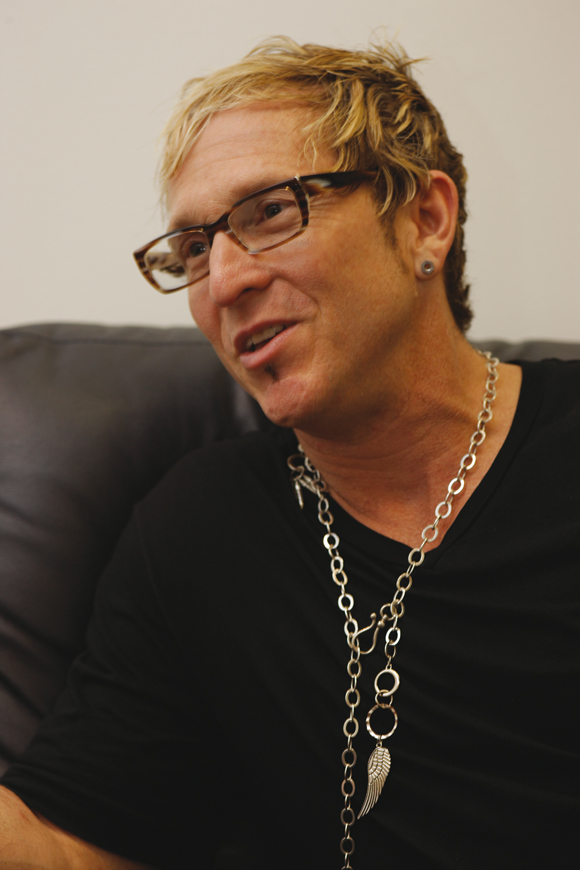 You’re a maple fan. Why?
You’re a maple fan. Why?
I have always been a big maple fan. I have played maple kits, birch kits, walnut kits. The second snare on my kit is actually a little Bubinga drum, a 12 inch. Generally I like maple. It has organic tone, organic decay. You talk about the maple drums as being wider and having longer decay time, whereas birch, is a little more controlled. They’re studio drums. The decay times are really a lot more determined by the heads. Thinner head, longer decay time. Thicker head, shorter decay time. You can lower the tuning with thicker heads.
You’re a Sabian cymbal guy…
Been a Sabian cymbal guy for 21 years. I originally I bought them because they sounded like Zildjians but were 10% cheaper. Now I am addicted to the sound like everyone else. I do a lot of seminars and I tell the kids, I play what I like. The metaphor I draw is, you hug your wife or girlfriend or boyfriend and they feel right. You sit down with an instrument, guitar, bass or drum, cymbal … you hit it … you play it … either it feels right or it doesn’t. I feel very at home with the gear I play now.
What about your electronic gear?
I play the Roland T20 kit, then we have the expansion card in it so that I get an enormous amount of sounds. I use that for electronic sounds. I do have my second snare drum triggered. I also have a 3rd bass drum pedal. I think what Roland has created is amazing. I have actually done a few sessions on Roland drums as well. The emulation acoustic drums are great and with the expansion kit, you can get a lot of electronic stuff too which is great.
What about sticks?
Vic Firth. I use the Extreme 5 Bs. I look at it as a middle weight stick. A lot of people think it’s a heavy stick, it’s not.
Heads? My tech and I are in love with these new Remo coated Vintage Emperors on the toms. They are utterly magnificent and I use the Powersonics on the kick drum and coated CS, the beefiest CS head.
I believe you can beat yourself up a bit on stage, do you still use gloves?
I still use gloves because with all the weather changes, particularly when it gets dry, my fingers start to crack open. I play cello on this tour too. I run up and play cello on one song, so if I had cracked fingers playing cello, It would really hurt.
What are the casualties on a tour like this? How many pairs of sticks etc do you go through?
Well, when we played Wembley in the UK I broke two crashes in the same place. Two 19″ Sabian Gold crashes. You know it was Wembley and sometimes the energy gets … you know I’m a pretty ferocious player. I play pretty hard. I need to use a lot of motion and I generally I tend to spare heads. We have managed to keep the same set of tom heads on my kit for a month. Generally, I pull the sound out, but every now and then I lean into it a little bit and hurt somebody or something. Occasionally I’ll break a stick. My tech is behind me and I try to be cautious but every now and then a stick flies by and hits him in the head. He was joking about wearing a hockey mask
What does Pink ask of you as a band?
The thing about Pink is she is one of the most disciplined hardest working people I have ever known. When you are on stage with her you feel that. You are motivated by how amazing she is. She is spinning around doing aerial aerobics on silks and on a trapeze hanging upside down and singing at the same time, while she’s doing flips. So I like at that think, my job is easy. I just have to play drums. I just give every ounce of energy that I can. My feeling is if I don’t get off that stage and completely exhausted and drenched in sweat then, I haven’t given my all. And she gives her all. We take great pride in being in there. She gets lumped into the same category as people like Britney Spears, but she is nothing like her. Pink is one of the hardest working people in show business and she is nothing like anyone else. So you’ve got to come to the table or she knows it. When she jumps up on my drum riser and stares me in the eyes, I give every bit of energy I have got.
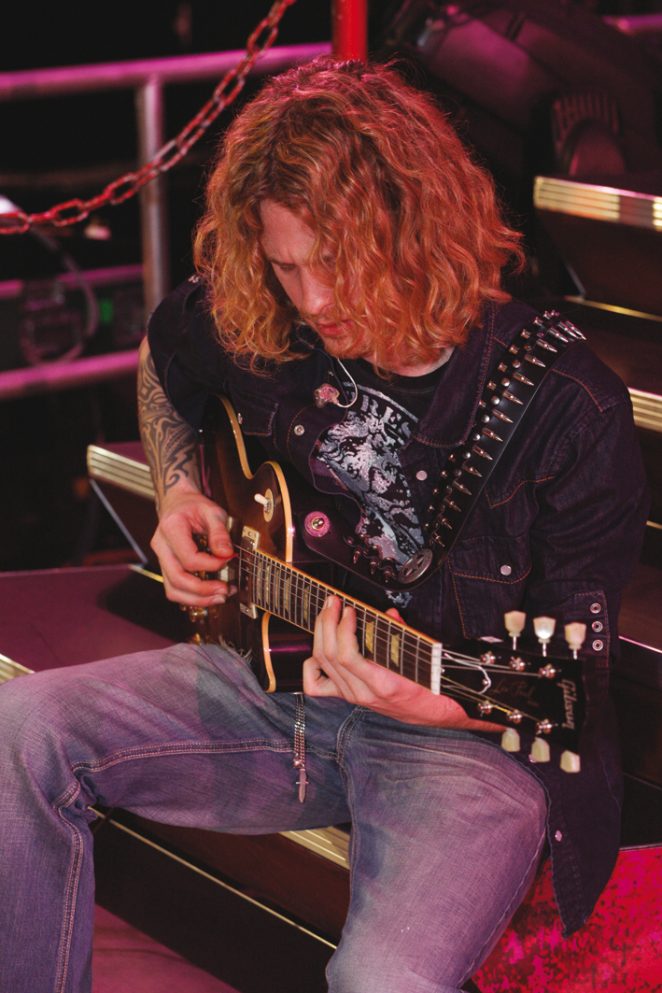 JUSTIN DERRICO – LEAD GUITARIST
JUSTIN DERRICO – LEAD GUITARIST
Prior to joining Pink, Justin Derrico refined his chops at LA’s Musician’s Institute before making a name for himself in a short stint with US pop rockers The Calling.
You’re playing in one of the biggest rock tours going around now. But what else might you have become if not a rock star?
Probably pretty worthless! I started playing guitar when I was about 15 and never ever thought I’d be doing this professionally. But it was like a disease. I couldn’t keep my hands off the guitar. I would skip school to come home to play. It’s amazing I made it through school. If I had never had found the guitar, I’d probably be still sitting at home in Virginia
Do you remember your first guitar?
Yes! It was a copy of a Telecaster. It cost me a hundred dollars. It had palm trees and pineapples and weird stuff all over it . It was a piece of crap but I loved that thing.
Apart from your obvious guitar skills, what other factors do you think got you this gig?
Paul called me up to audition. There were maybe 8 or 10 other guys, all really good players. I learned everything, all the parts. When I walked in and met her, we just had a vibe, we hit it off. She liked my vibe and they hired me on the spot. They said see you in Budapest in a week. So I had to learn like 27 songs in a week.
The Les Paul is your main guitar?
I’ve had that one for a while. I got it in 2006 around when I started with Pink. It’s a real workhorse. It stays in tune. I also use an Axcess on the show which Gibson just came out with. That thing is amazing. It’s a Les Paul with a Floyd Rose and there is no heel, so it slopes into the body. You can get up high and shred.
What are the pickups?
Just stock burstbuckers. But the one thing I have on all my Les Pauls is a Fishman piezo bridge. So on this tour when I do ‘Babe I’m Gonna Leave You’ or on the last tour there were acoustic and electric bits, it allows me to get a really nice acoustic sound from my electric guitar. Some people really freak out abut the sounds I get out of a Les Paul. That guitar took a spill a few months ago and the headstock snapped but I got it repaired. The neck is a 60s neck. so thinner than the 50s. I don’t have the biggest hands.The 60s necks are a bit more comfortable for me. I do have a couple of Les Pauls with big fat 50s necks and they feel great. I can get around them well, but some of the bigger necks I just fight. String wise, I use tens.
You’re a Bogner amp user?
When I moved to LA I started getting gigs. A friend of mine said you gotta check out these Bogners. He knew Reinhardt Bogner and he took me down there. I played a little bit and checked out 3 different models,the Uberschall, the Ecstasy and The Shiva. Between all those amps the Shiva was the one ‘I’ came out of. The others were a little sterile sounding for me. The Shiva doesn’t have the most gain, so I dial the gain all the way up and I get a little bit more when I dial in the Master Volume as well. Pushing the amp a little harder bit. It is a big sounding amp.
Are you a pedal freak?
You know if it were up to me, I’d probably just have a wah, delay and distortion, but for this gig I have to have a lot of sounds to copy what’s on the record and to beef things up. Actually my pedal board has a pedal board. I do some stuff on wireless, so my tech has to change pedals while I’m on the B stage so that’s pretty gnarly.
We’ve been speaking abut how you guys have a lot of cues to look out for. Is there anyone in particular you focus on stage?
I always have my head up looking at Paul quite a bit. There are a lot of cues on the end of things. I am cueing off Mark. Some of the fills he does … he is telegraphic about. It’s like OK, we’re going to stop here. There is a cue in ‘Party’ where she is spinning and flying around and stuff and I’m just soloing over the outro and there’s this cue thing and sometimes it’s in the middle of a phrase. So sometimes it’s hard to be soloing and being into it and being able to look over at Paul, even though Paul is a rockin’ dude, but I just look to Mark.
Note: Pink and band use Australian manufactured Maton for their acoustic guitars
 EVA GARDNER-BASS
EVA GARDNER-BASS
Bassist Eva Gardner has been with the band for a couple of years. Her bass playing can be heard on the Mars Volta’s first EP ‘Tremulants’. Her father was Kim Gardner, bassist from US underground legends from the 60s, The Creation. When not playing with Pink she records and performs with her own band called Lyra.
How long have you been with Pink and how did it come about?
I’ve had the gig 2 years now. I got it through the MD Paul. I had auditioned for another gig he was MD for, the INXS Rockstar gig, so he knew me. It was pretty quick, He needed someone quickly. I found out the night of the audition. He just said be ready to leave in 4 days and learn all the material.
You were playing with your own band, Lyra, at the time …
Yes, we’re based in LA. It’s a band I’m in with other fellas, but between us someone is always doing something else. When we are home, we’ll do Lyra. We play places like Troubadour, Spaceland. We’ve recorded two EPs but if we get called for a tour, the tour become the priority. You know… you get to travel, get paid for it, have a great time.
What do you learn on a tour like this?
I think how to work with a large group of people who do many different things. You have to make sure you do what you do, be on time and do your job because it effects everyone else.
Being a bass player, do you naturally hone in on what Mark, the drummer is doing?
Definitely I am listening to Mark the whole time.
Is Mark a different kind of drummer than you were used to playing with?
I have played with funk drummers, punk drummers, African drummers all kinds. Mark is one of the most solid though.
You’re into a bit of prog rock and played on the ‘Tremulants’ EP, the first recording by The Mars Volta. What was that like?
It was amazing. A time where the whole band was creating together, a real collaboration and a chance to express myself as a bass player.
Coming from that to this, I suppose it helps to make you the total musician?
Yeah I just like being a versatile musician. I go into a job and do what needs to be done. If they need me to play a lot I do that. If I need to lock in I can do that too.
What do you play on stage?
I use a Fender Precision, a custom bass modelled after my father’s favourite bass. It was a 1962 Fiesta Red Fender Precision. It was his baby. I have it now, but it is not something I’d want to take on the road. I had a duplicate made of it and it has a little plate on the back of it dedicated to him.
Are you a collector?
I have all of my dad’s instruments… a ’58 Precision, a ’62, all kinds of different stuff.
Was there any doubt you’d be a bass player?
Never. It was one of the first things I remember, is knowing what I wanted to do at six or seven, before I even knew what that was. I said I want to be a bass player. Couldn’t see myself doing anything else
What amp are you using?
Ampeg. 8x 10 cabinet. Its a pro head, all tubes. I’m endorsed by both Ampeg and Fender
Effects?
The only thing I am using on this tour, is the Turbo Rat for distortion on quite a few songs to give a bit of a distorted sound.
And when you’re on your own?
I don’t know … a lot of the times I have played with other people, the guitarists have had a lot of crazy effects and sometimes it is really appropriate for me to just be solid, laying down the foundation. Look at Mars Volta. The drums had effects, the vocals, the keys. I was the only one who didn’t. I mean I used an Octapedal here and there but it kind of got too much.
You toured here with Veruca Salt, what are your memories?
Oh man, it was such a fun time. My first time in Australia. A great way to see the country in a nut shell. Everyone was great. Hoping to come back and I have twice now. We did clubs and festivals and it was summertime.
 KAT FATALE (LUCAS) – GUITAR, KEYBOARDS
KAT FATALE (LUCAS) – GUITAR, KEYBOARDS
The energetic Kat Fatale, is a Toronto based musician who plays guitar, keyboards and sings with this band. Before joining Pink in January 2009, Kat had been working with a bunch of different artists from Toronto, including Shilo. and Sky Sweetnam.
How did you get the Pink gig?
Basically I always thought it would be cool to work with Pink. I was listening to the news or something and they were saying that Pink has a new album coming. So I emailed Mark the drummer on Myspace or Facebook, not thinking he would get back to me.
I just wrote that I am a professional musician from Toronto and I would love to work with her… let me know if you need anyone. Months had passed, they had hired people. I guess it didn’t work out. Then I got this call Christmas day from Mark. He said fly yourself out to LA in January. So I went, did an audition and got the gig.
You’re playing guitar, keys and singing in this band. How did Paul work out which keyboard parts you would play?
I guess a lot of it was based on what the other keyboardist was doing. When we got to rehearsals in LA we listened to the track and picked out what made sense, and what he wanted to play. Just putting our minds together.
And you play guitar on the more rockier songs?
I think it just depends on what songs need filling out and yeah I guess it’s the more rockier ones. I play a Gibson Flying V which I got when I came to get the gig. I contacted Gibson and they sent it to me. I play through Bogner amps. Justin is hooked up with them. I was playing Orange amps in Toronto.
Any effects?
Not really, mostly just rhythms. On one song I use some delay through a Line 6. Keyboard wise I am using a Roland Fantom X8. I was using Yamaha before but this Roland was set up with all the sounds and it would have been a hassle to bring out all my gear.
What have you learned in your few months with Pink?
A lot. I mean its just great to work with people who have been dong it so long. I find feeding off each other and learning to listening to each other. Especially since there are tracks and a bunch singers. I don’t think I have ever worked in a band with so many different vocal parts going on at the same time, so there are two back up singers and me … so learning how to blend with them and listening to Pink.
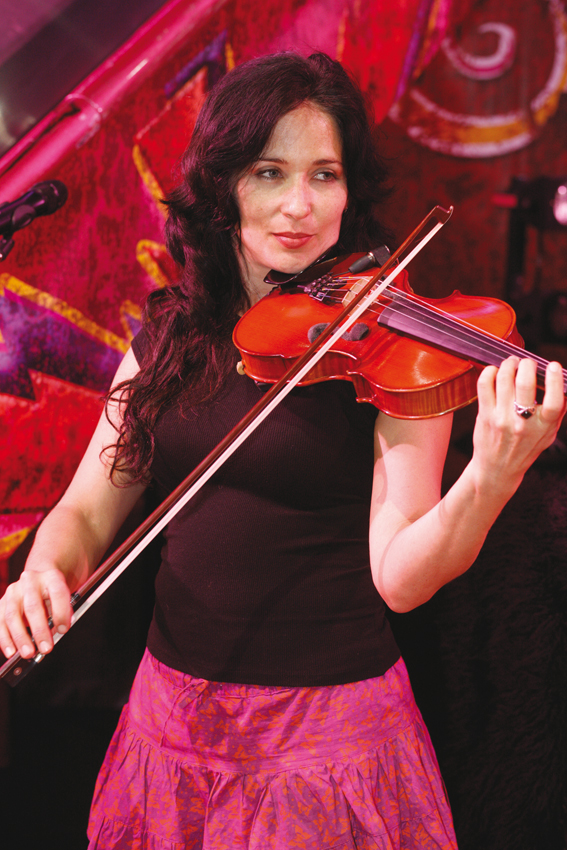 JESSY GREENE-VIOLIN
JESSY GREENE-VIOLIN
Pink’s violinist Jessy Greene was the only band member I failed to interview on the day I was present for sound check. However when an international band is in the country for near on three months, it isn’t too hard to catch up, as we did via the phone a couple of weeks later.
A wayward youth has been the catalyst for many a rock musician’s career path. For Jessy, as a teenager music was crucial. It’s the one thing that fed her joy and kept her going. It was the playing of music that mattered, the interaction between other musical souls. Greene is a classically trained violinist but her first real taste of life on the road in a rock band came when she fled to LA and joined The Geraldine Fibbers. Immersing herself in the vibrant American musician scene, Jessy began jamming with various bands and hooked up with uber cool outfits like Golden Smog, a group featuring members of Soul Asylum, Replacements, and Wilco. From there, Jessy shared the stage with Wilco, REM and The Jayhawks and in 2003, found time to record her first solo album Blue Sky. In 2007 one of her biggest international breaks came when The Foo Fighters asked her to join their world tour. Jessy recently released her second solo disc A Demon and Her Lovers , an album of ambient electro beats, and earlier this year joined Pink’s band after auditioning for musical director Paul Mirkovich.
Jessy’s violin playing can not only be heard during Pink’s quieter concert moments, but she also gets to rock out throughout the show. “The violin I play is called a Dahlia 5-String acoustic and it is made by Gary Bartig of Edward Lutherie Inc,” Jessy told me. “It features an external pick up, which is easy to install under the bridge. It is called Pick Up The World.”
As part of Pink’s band, Jessy sees her role as “playing what is appropriate, having fun, but also doing my job.” When playing her own material however, Jessy explores a lot more sonic possibilities utilising a range of effects. “With Pink, I use a I do use a Demeter DI , reverb pedal and a wah wah.” On her own though, the violin is played through a Demeter amp featuring 50/100 watt head, modelled after a vintage Marshall. The cabinet has 2 x 12″ vintage speakers. “I use a Fulltone Bass-Drive, a Boss octave pedal, a bunch of different delays and occasionally a wah wah pedal.”
On top of Jessy’s wish list of artists she would like to play with is Radiohead. However, since joining Pink’s band, Jessy has struck up a creative musical union with fellow Pink newcomer Kat Fatale. They have written several songs together and hope to record as soon as this tour is done.
Despite being ill for most of the day, Pink went on to perform a stunning show that night with her dynamic band playing amazingly tight. Thanks to Paul Mirkovich and band for a fantastic day. Thanks to Pink for the loan of them!


